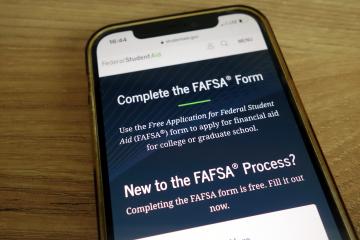
Overcoming administrative burdens: Strategies to increase FAFSA filing in the United States

A new J-PAL policy insight highlights evidence from randomized evaluations on interventions to increase FAFSA filing rates. The insight found that informative and timely nudges can increase FAFSA filing, but that providing hands-on support—such as coaching—may yield more substantive outcomes. In this post, we situate these findings within the larger context of higher education and barriers to accessing public programs, also known as “administrative burdens.”
Higher education is an important gateway to economic mobility in the United States. A college education can lead to higher earnings, lower unemployment, and better health. However, there are many barriers to accessing postsecondary education, such as burdensome college application and enrollment processes and high financial costs. To address cost barriers, the US government has developed programs aimed at helping students afford college, including loans and Federal Pell Grants. To access these programs, students must complete the Free Application for Federal Student Aid (FAFSA).
Accessing student aid in the United States
The FAFSA application has been criticized as complex and difficult. According to a 2021 survey, more than 30 percent of first-generation and low-income high school students found completing the FAFSA difficult. Students highlighted a lack of parental support, difficulty acquiring tax information, confusing questions, income changes, and complications due to citizenship status.
These challenges reveal two major types of barriers to completing the FAFSA, also known as administrative burdens: learning costs and compliance costs. Learning costs refer to the information required to complete the FAFSA, such as knowledge of deadlines, tax information, and eligibility requirements. Compliance costs are hurdles associated with fulfilling arduous requirements to complete the application, including meeting deadlines and completing verification processes.
Strategies to reduce administrative burdens
There is a growing body of evidence on strategies to reduce administrative burdens. One such solution is nudges—strategies designed to influence people’s behavior without changing legal or economic systems. Nudges have shown to be effective in various fields in the United States. In health care, informational nudges have small but meaningful impacts on both health insurance take-up and ensuring individuals switch to the plans that best serve their needs. In the criminal legal field, reminders—a low-cost behavioral nudge—have increased scheduled court appearances and reduced arrests associated with missing court.
A J-PAL policy insight, published in 2023, reviewed seven randomized evaluations and found that nudges can increase FAFSA filing in the United States, particularly when messaging is personalized and timely. However, the impacts of nudge interventions were inconsistent across studies and sometimes dissipated over time. For example, nudges that only provided information were generally insufficient to increase filing. Initial evidence suggests that hands-on assistance may yield more substantive results.
Areas for future research
The impact of hands-on and personalized support to increase access to and retention in higher education is consistent with a growing body of evidence on coaching and wraparound supports in education. A study in Toronto found that providing school-based workshops, in conjunction with fee waivers, boosted college application and enrollment rates. A New Hampshire study found that a high school in-person mentoring intervention increased enrollment among women. A policy insight on reducing community college dropout through comprehensive supports showed that providing personalized support tailored to the students’ needs help students stay enrolled, and in some cases, improve graduation rates.
There are also exciting policy innovations that warrant future research. For example, the FAFSA Simplification Act is slated to go into effect in December 2023 for the 2024-25 school year. The Act addresses a number of barriers to FAFSA completion, such as by streamlining the application and pulling income data directly from the Internal Revenue Service (IRS) when possible. While these advancements will likely help tackle many of the burdens FAFSA places on students and their families, we do not yet know what the Act’s impact will be.
Overcoming barriers to postsecondary education requires evidence-informed solutions. New policies—like the FAFSA Simplification Act—are key opportunities to generate new evidence, continue to innovate, and determine whether these interventions are generating the desired impact.
If you are interested in evaluating strategies to increase access to postsecondary education, please contact Policy Manager Laina Sonterblum.
This post is part of an ongoing series on interventions to overcome administrative burdens and increase access to public programs in the United States. The first piece focused on increasing take up of subsidized health insurance.
Related Content

Overcoming administrative burdens: Strategies to increase access to health insurance in the United States

Too complicated, too confusing: why more small businesses aren’t applying for coronavirus relief loans, and what we can do to reach them


